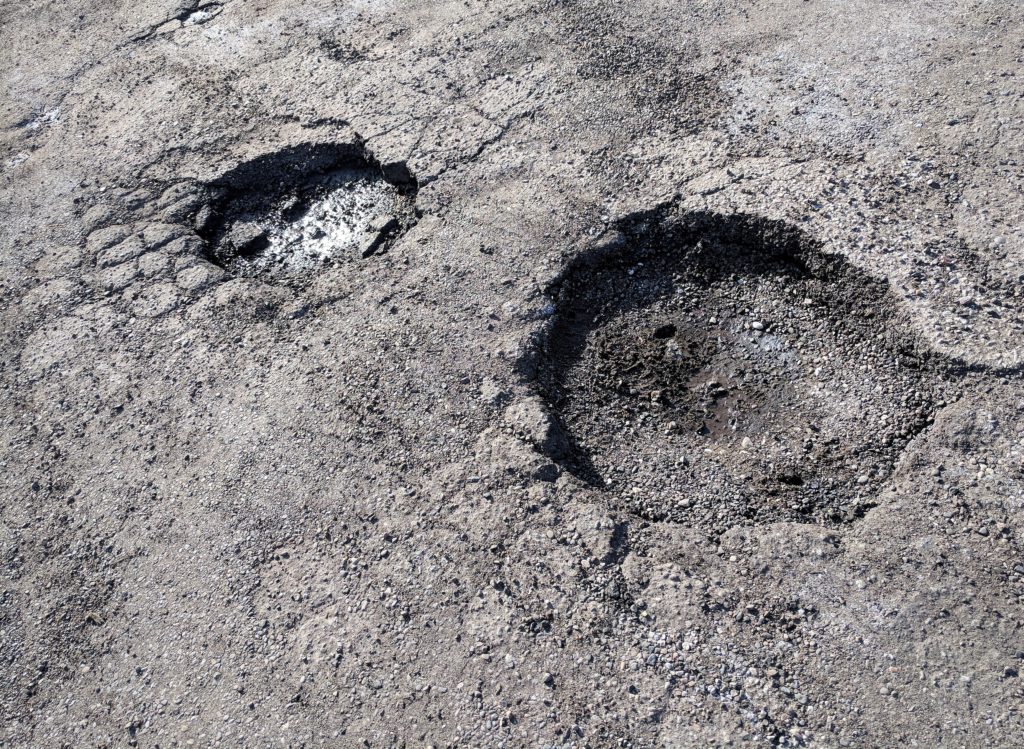
Photo of Flint pothole by Paul Rozycki
By Paul Rozycki
Gov. Whitmer is continuing her statewide campaign to garner support for a 45 cent gas tax increase, which would be used to “fix the damn roads.” It remains to be seen whether or not she will get what she wants. Most public opinion polls show little support for the large increase. Republicans in the legislature have already called the proposal a “non-starter,” and it seems to have little chance of success in Lansing.
Yet, the pressure is building to do something to fix the roads. Last month’s East Village Magazine column looked at some of the options the state might consider to raise the needed $2.5 billion. If that happens, how that happens, and when that happens, are large and uncertain questions. But that’s only half of the problem.
Let’s say, one way or the other, the state finally finds a way to raise the money. The next question is — who gets it?
While raising the funds for the roads might be controversial and divisive, the process of spending those funds could be just as contentious.
What is Act 51?
Conspiracy theorists and UFO aficionados have long written about Area 51, a secretive base in Nevada, said to be home to space aliens, flying saucers, and other things beyond our world. While not from outer space, Michigan’s Public Act 51 (PA 51) may prove to be as mysterious as Area 51, especially to those trying to “fix the damn roads.”
There are many policies for distributing money for the roads in Michigan, but the most important one, passed in 1951, is usually referred to simply as Act 51. Its main purpose is to distribute road funds throughout the state, and decide how much money goes to the state, county and local roads. There are plenty of complex details in the law, but the basics are fairly simple. Based on Act 51, 39 percent of the road funds are set aside for state roads, 39 percent for county roads, and 22 percent for local municipalities, such as cities and villages.
That seems fairly simple and straightforward. However, when the funds are distributed to Michigan’s 83 counties and more than 500 cities and villages, it gets a lot more complicated and contentious. How do you decide who gets the money? Should it be based on equality? Population? Number of cars? Miles of roads? Amount of traffic on the roads?
When giving road money to local governments, Act 51 does some of all of those things. For counties, 56 percent of the funds are based on auto registration taxes collected in the county, 24 percent based on road mileage, 11 percent is given out equally, and nine percent is based on population.
For cities and villages, 60 percent of the money is given based on population, and 40 percent is based on local road mileage. Though not officially part of the state road system, townships frequently contribute to the maintenance of some county roads, and are often expected to cover the local cost portion of some roads. About a third of local governments supplement their state money with local taxes or millages, and often local governments must match state dollars to receive the road funds.
As daunting as those numbers seem, it’s even more complex than that. There are also special provisions for bridges, snow removal, roadside parks, non-motorized paths, bond issues, public transportation, and many other parts of the highway system.
What’s wrong with Act 51?
So, even with all the complexity, what’s the problem with Act 51?
In the eyes of many, there are two major issues. It doesn’t allocate money where it is most needed, and politically it pits one part of the state against another.
A number of groups, most significantly the Citizens Research Council of Michigan, have argued that Act 51 doesn’t allocate funds where they are needed most, and that some of the state’s most heavily traveled roads get shortchanged, while other areas, with more road mileage and less traffic, get more than they need. They point out that a two-lane road receives the same funds as a four- or six-lane road, and that the roads with the greatest use, and those in the worst shape, often don’t receive priority.
Some roads are clearly more heavily traveled than others. Michigan’s major highways, what are called the trunkline roads (the interstates, and highways with a U.S. or M designation), include only about 8 percent of the road miles, but have 51 percent of the traffic. County roads include 74 percent of the road miles, but only handle about 31 percent of the traffic.
While measures such as population, road mileage, and vehicle registrations aren’t a bad measure when roads are in decent shape, they are a poor way of allocating funds when the roads are in a “crisis” mode, as many of Michigan’s roads are.
Though there is fairly widespread agreement that the nearly 70-year-old law needs changing, in light of current population and transportation needs, there has been little movement in the legislature to update Act 51. Why? Because any change in the law will shift resources from one part of the state to another, and will create winners and losers in state funding.
In general, a revision of the law would probably cost the rural areas of the state, and aid the urban and suburban areas. But within each of those areas, there will also be winners and losers. Any change will shift money from one county to another, from one city to another, or one village to another. The politics are difficult. Because of the potential conflict, the law has often been called “the third rail” of Michigan highway funding, where no lawmaker wants to touch it. Several attempts to modify Act 51 fell by the wayside in recent years.
Future challenges and solutions
Even if the governor is able to raise the $2.5 billion for the roads, if that money is pumped through the current Act 51 system, it will be less effective than it might be on the roads most needing repair. Those roads with the most need of repair may receive less than they need, and others will receive more than needed.
John Daly, who served as manager-director of the Genesee County Road Commission for 18 years, argued that there is no provision for local governments to develop economies of scale in repairing the roads, and that all too often, local governments are forced to do quick repairs rather than long-term fixes. In the long run, those short-term fixes are both inefficient and costly. He suggested that the governor create a task force (The New Strategies Task Force for the Governance and Financing of Michigan’s Roads and Bridges) to review current policies for road and bridge repair and make appropriate recommendations.
Michigan has ranked near the bottom of the 50 states in terms of its per capita road funding for many years, and that has given us the “road crisis” we now face. Almost half the roads in the state are in “poor”condition, and getting worse by the day, according to one recent survey.
Raising the money will be no easy task, and any attempt to raise the needed funds will face stiff opposition from one group or another. But, given the anger over the condition of the roads, it’s possible that funds will be found. In addition to finding the money to “fix the damn roads,” fixing the way we spend the money, with Act 51, will almost certainly be more challenging, but might be just as important, if we are going to fix the roads effectively.
EVM political commentator Paul Rozycki can be reached at paul.rozycki@mcc.edu.


You must be logged in to post a comment.